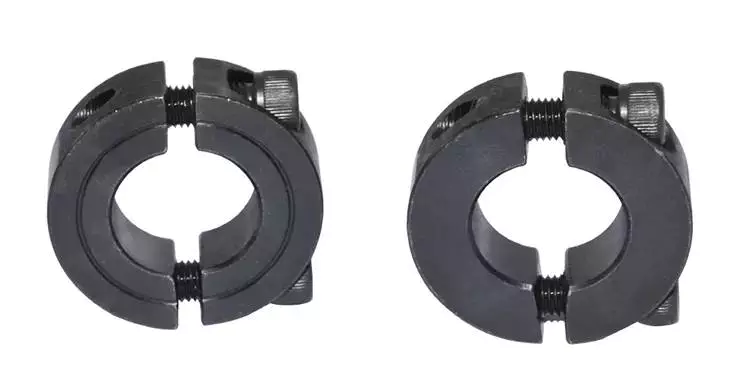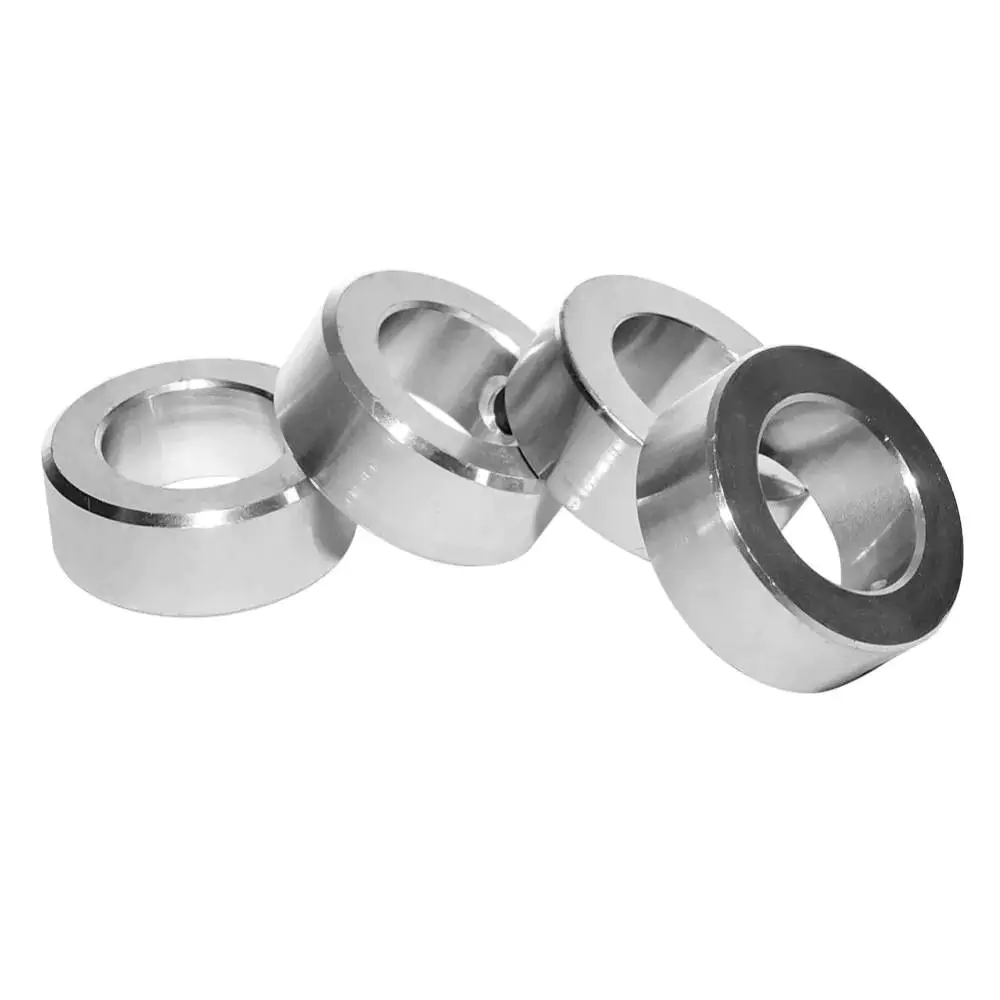
What are the temperature and corrosion resistance properties of shaft collars?
The temperature and corrosion resistance properties of shaft collars vary depending on the materials they are made of. Different materials exhibit different levels of resistance to temperature extremes and corrosion. Here are some commonly used materials for shaft collars and their temperature and corrosion resistance properties:
- Steel: Steel shaft collars, particularly those made from stainless steel, offer excellent temperature and corrosion resistance properties. Stainless steel is known for its high strength, durability, and resistance to rust and corrosion. It can withstand a wide range of temperatures, from low cryogenic temperatures to high heat environments. Stainless steel shaft collars are often used in applications where exposure to moisture, chemicals, or harsh environments is a concern.
- Aluminum: Aluminum shaft collars have good temperature resistance properties and can handle moderate temperature ranges. They are lightweight and offer reasonable corrosion resistance. However, aluminum is not as corrosion-resistant as stainless steel and may be susceptible to certain chemicals or highly corrosive environments. Aluminum shaft collars are commonly used in applications where weight reduction is a priority, such as aerospace or automotive industries.
- Plastic: Plastic shaft collars, such as those made from nylon or acetal, have limited temperature resistance compared to steel or aluminum. They can typically handle moderate temperatures but may deform or degrade at higher temperatures. Plastic collars are not as resistant to corrosion as metal collars but can still offer good resistance to certain chemicals and environmental conditions. Plastic collars are often used in applications where weight, cost, or electrical insulation properties are important factors.
- Brass: Brass shaft collars offer good temperature resistance and moderate corrosion resistance. They can handle a range of temperatures and are often used in applications where a combination of durability, conductivity, and aesthetics is required. Brass collars may tarnish over time but can still maintain their functionality and structural integrity.
It is important to note that the temperature and corrosion resistance properties of shaft collars can also be influenced by factors such as the specific alloy composition, surface treatments, and environmental conditions they are exposed to. When selecting shaft collars for your application, it is crucial to consider the temperature range and potential exposure to corrosive substances or environments. Consulting with manufacturers, reviewing technical specifications, and considering industry standards or guidelines can help ensure that you choose shaft collars with appropriate temperature and corrosion resistance properties for your specific needs.

Can I find information on using shaft collars for positioning and securing components?
Yes, you can find a wealth of information on using shaft collars for positioning and securing components. Shaft collars are versatile mechanical devices that are widely used in various industries and applications to provide precise positioning and secure fastening of components on shafts. Here are some sources where you can find valuable information on using shaft collars for positioning and securing components:
- Manufacturer Websites: Many shaft collar manufacturers provide detailed information on their websites about the applications, installation techniques, and benefits of using shaft collars for positioning and securing components. They often offer resources such as product catalogs, technical specifications, installation guides, and case studies that showcase real-world applications. Visiting manufacturer websites can provide valuable insights into the capabilities and best practices associated with shaft collar usage.
- Online Resources and Blogs: There are numerous online resources and blogs dedicated to mechanical engineering, industrial applications, and component usage. These platforms often feature articles, tutorials, and guides that specifically address the topic of using shaft collars for positioning and securing components. Websites of engineering associations, industry publications, and educational institutions can be excellent sources of information in this regard.
- Technical Forums and Discussion Boards: Online technical forums and discussion boards are vibrant communities where professionals and enthusiasts share their knowledge and experiences. Participating in these forums or browsing through relevant threads can provide valuable insights and practical tips on using shaft collars for positioning and securing components. Users often discuss specific applications, troubleshooting techniques, and innovative use cases, offering a rich source of information.
- Engineering Books and Publications: Engineering books and publications covering topics such as mechanical design, machine elements, or industrial automation often include sections or chapters dedicated to shaft collars and their applications. These resources provide in-depth explanations, theoretical foundations, and practical examples of using shaft collars for positioning and securing components. Libraries, online bookstores, and academic institutions are good places to access these resources.
- Professional Networking: Engaging with professionals in the field, such as mechanical engineers, designers, or maintenance technicians, can provide valuable insights into the practical aspects of using shaft collars for positioning and securing components. Participating in industry conferences, seminars, or workshops, or connecting with professionals through social media platforms like LinkedIn, can facilitate knowledge sharing and discussions on best practices and real-world applications.
By exploring these sources, you can acquire a comprehensive understanding of the principles, techniques, and considerations involved in using shaft collars for positioning and securing components. It is important to consult multiple sources and consider the specific requirements of your application to ensure the most effective and reliable use of shaft collars in your projects.

Are there tutorials on the proper installation of shaft collars?
Yes, there are tutorials available that provide guidance on the proper installation of shaft collars. These tutorials can be helpful for individuals who are unfamiliar with the installation process or want to ensure that they are installing the collars correctly. Here are some common sources where you can find tutorials on the installation of shaft collars:
- Manufacturer Websites: Many manufacturers of shaft collars provide detailed installation instructions on their websites. These instructions may include step-by-step guides, diagrams, or videos that demonstrate the proper installation techniques. Visiting the websites of specific collar manufacturers and exploring their resources section or product documentation can help you find the installation tutorials you need.
- Online Industrial Communities and Forums: Industrial communities and forums dedicated to mechanical components or equipment often have discussions or threads related to the installation of shaft collars. Participating in these communities and posting inquiries about installation techniques can help you connect with professionals or experienced users who can provide guidance or share their knowledge.
- Video Sharing Platforms: Platforms like YouTube or Vimeo host a wide range of instructional videos, including tutorials on the installation of various mechanical components. Searching for “shaft collar installation tutorial” or similar keywords on these platforms can yield helpful videos that visually demonstrate the proper installation techniques. Watching these videos can provide a clear understanding of the installation process and any specific considerations to keep in mind.
- Trade Publications and Magazines: Trade publications or magazines related to mechanical engineering, industrial equipment, or power transmission may feature articles or guides on the installation of shaft collars. These resources often provide detailed explanations, tips, and best practices for proper installation. Checking these publications or their online platforms can give you access to written tutorials or expert insights.
- Online Documentation and Manuals: Some manufacturers or suppliers provide downloadable documentation or manuals for their shaft collars. These documents may include installation instructions along with other technical information. Searching for the specific collar model or brand, followed by keywords like “installation instructions” or “user manual,” can help you find relevant documentation that covers the installation process.
When using tutorials for shaft collar installation, it is important to ensure that the information is sourced from reputable and reliable sources. Follow the provided instructions carefully, and if in doubt, consult with professionals or seek guidance from the manufacturer. Proper installation of shaft collars is crucial for their effectiveness, reliability, and the overall performance of the machinery.


editor by CX 2024-01-16